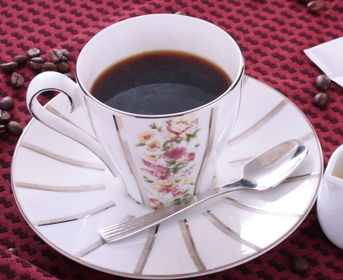What's the difference between caffeine and decaffeinated?
The most remarkable thing about caffeine is that the taste of coffee has nothing to do with how much caffeine it contains. Caffeine itself has a slight bitter taste, and its concentration basically comes from the degree of roasting (the deeper it is, the thicker it is). The concentration of coffee is formed by the ratio of coffee to water in the process of brewing.
Bullet an average 142g cup of coffee contains 60-180mg (mg) of caffeine, depending on the concentration of coffee and the type of coffee used when mixing.
Bullet A cup of ordinary 42g (g) Espresso contains 90-120mg (mg) of caffeine. The amount of caffeine also depends on the concentration of coffee and the type of coffee used when mixing.
Bullet roasting process has little effect on caffeine. Caffeine above 77 degrees Celsius can be quickly dissolved in water, so it has been completely dissolved with coffee during brewing.
Bullet different types of coffee trees also contain different amounts of caffeine. Arabica coffee contains about 1% per cent caffeine, while robusta coffee contains about 2% per cent caffeine.
Whether caffeine has an effect on health is a topic of great concern to many people. So far, no conclusive evidence has been found that drinking coffee is harmful to human health.
Many studies have shown that coffee is actually good for the human body in many ways. For example, coffee can stimulate athletes to create better results, and the moderate stimulation caused by coffee is beneficial to many daily activities, such as relieving work stress, refreshing effect, and so on. Drinking a moderate amount of coffee will not affect human health, but it is a good drink.
All ways to remove caffeine are to increase the moisture content of green coffee beans (unroasted coffee beans), making it easy to remove caffeine. The caffeine is then extracted with a solvent, dried in the sun, and shipped to the roaster.
The solvents used to remove caffeine include water, ethyl acetate, chloromethane and carbon dioxide. These methods can be used to produce safe, good-tasting decaf coffee. The flavor of decaffeinated coffee depends on the quality of the beans, the properties of the blend, the roasting techniques and the methods used to remove caffeine.

Important Notice :
前街咖啡 FrontStreet Coffee has moved to new addredd:
FrontStreet Coffee Address: 315,Donghua East Road,GuangZhou
Tel:020 38364473
- Prev

Traditional Chinese medicine talks about coffee and sees how to feel the pulse of coffee.
Coffee is an imported product, when Western culture collides with traditional Chinese medicine culture, let's see how traditional Chinese medicine feels the pulse of coffee! The coffee bean is taken from the fruit of the coffee tree. It is red and red in color, enters the heart, is bitter, and merges into the path of the large intestine. The taste is bitter and bitter, fried and scorched. Glycol has the effect of nourishing and relieving pain, relieving pain, diverging pungent flavor, passing through the brain-blood barrier and treating surface wind and heat.
- Next

Coffee knowledge what is the effect of coffee on the human body
Different people and different bodies have different responses to coffee, and the human body has a wide range of responses to food and drinks (including coffee). There are different conditions at different times, and a few people do suffer from insomnia, tension, gastrointestinal discomfort, palpitations and other reactions after drinking one or two cups of coffee. Only about 1% of drinkers will have these reactions, but there is no certainty.
Related
- Beginners will see the "Coffee pull flower" guide!
- What is the difference between ice blog purified milk and ordinary milk coffee?
- Why is the Philippines the largest producer of crops in Liberia?
- For coffee extraction, should the fine powder be retained?
- How does extracted espresso fill pressed powder? How much strength does it take to press the powder?
- How to make jasmine cold extract coffee? Is the jasmine + latte good?
- Will this little toy really make the coffee taste better? How does Lily Drip affect coffee extraction?
- Will the action of slapping the filter cup also affect coffee extraction?
- What's the difference between powder-to-water ratio and powder-to-liquid ratio?
- What is the Ethiopian local species? What does it have to do with Heirloom native species?

